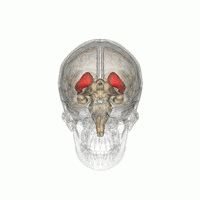DaT scan
This article needs additional citations for verification. (September 2020) |
| DaT scan |
|---|




DaT Scan (DaT scan or Dopamine Transporter Scan) commonly refers to a diagnostic method, based on SPECT imaging, to investigate if there is a loss of dopaminergic neurons in striatum. The term may also refer to a brand name of Ioflupane (123I) tracer used for the study. The scan principle is based on use of the radiopharmaceutical Ioflupane (123I) which binds to dopamine transporters (DaT).[1] The signal from them is then detected by the use of single-photon emission computed tomography (SPECT) which uses special gamma-cameras to create a pictographic representation of the distribution of dopamine transporters in the brain.[2]
DaTSCAN is indicated in cases of tremor when its origin is uncertain. Although this method can distinguish essential tremor from Parkinson's syndrome, it is unable to distinguish between Parkinson's disease, Dementia with Lewy bodies, Parkinson's disease dementia,[3] multiple system atrophy or progressive supranuclear palsy.
There is evidence that DaTSCAN is accurate in diagnosing early Parkinson's.[4][5]
Procedure
[edit]At the beginning a patient should take two iodine tablets and wait for one hour. These pills are important because they prevent the accumulation of radioactive substances in the thyroid gland. After one hour, the patient gets an injection to the shoulder, which contains the radiopharmaceutical, and then waits for 4 hours. The concentration of the substance increases, and then it is scanned by a gamma-camera, which is located around the patient's head. The whole examination lasts about 30–45 minutes, and it is non-invasive.
If a patient uses certain medications listed below, it is necessary to stop usage for a few days or weeks before the DaTSCAN, but only after a consultation with the patient's doctor.
The examination takes just a few hours, so patients do not need to stay in a hospital overnight, but they have to drink much more than they are used to and go to the toilet more often. It is important for a fast elimination of the radioactive substances from the body.
Contraindications
[edit]- pregnancy
- breast-feeding
- severe renal or hepatic insufficiency
- allergy to iodine substances
- certain medications – stimulants or noradrenalin and some antidepressants
Differential Diagnosis
[edit]- Parkinson's disease, multiple system atrophy or progressive supranuclear palsy
- Essential tremor
- Lewy body disease
References
[edit]- ^ "DaTSCAN Summary of Product Characteristics" (PDF). European Medicines Agency. GE Healthcare. 25 July 2019.
- ^ Djang, D. S. W.; Janssen, M. J. R.; Bohnen, N.; Booij, J.; Henderson, T. A.; Herholz, K.; Minoshima, S.; Rowe, C. C.; Sabri, O.; Seibyl, J.; Van Berckel, B. N. M.; Wanner, M. (1 January 2012). "SNM Practice Guideline for Dopamine Transporter Imaging with 123I-Ioflupane SPECT 1.0". Journal of Nuclear Medicine. 53 (1): 154–163. doi:10.2967/jnumed.111.100784. PMID 22159160.
- ^ Yousaf, Tayyabah; Dervenoulas, George; Valkimadi, Polytimi-Eleni; Politis, Marios (2019-01-01). "Neuroimaging in Lewy body dementia". Journal of Neurology. 266 (1): 1–26. doi:10.1007/s00415-018-8892-x. ISSN 1432-1459. PMC 6342883. PMID 29761296.
- ^ de la Fuente-Fernández, Raúl (2012-03-06). "Role of DaTSCAN and clinical diagnosis in Parkinson disease". Neurology. 78 (10): 696–701. doi:10.1212/WNL.0b013e318248e520. ISSN 1526-632X. PMID 22323748. S2CID 264102115.
- ^ Diagnostic accuracy of DaTSCAN in Parkinson’s and clinically uncertain parkinsonism, Kevin Galbraith, January 2016
External links
[edit]- European Parkinson's Disease Association Archived 2011-12-11 at the Wayback Machine
- DaTSCAN Archived 2019-07-20 at the Wayback Machine
- Patient's view Archived 2011-10-14 at the Wayback Machine
